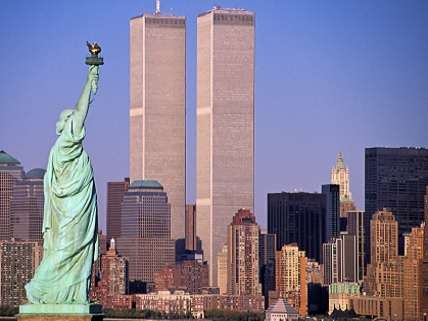9/11 in Real Time, As Reason Saw It
We owe it to the victims to remember that day in all of its horror but also to not be trapped by the past.

Among the very first articles this website published on this day in 2001 was then-Washington Editor Sam MacDonald's "Live from the Capitol Building":
I continued up the street until I came across a construction site. Near Dupont Circle, workers had a small black-and-white television set up on a makeshift table. Most of the people gathered there had already seen the footage over and over. Only one man came upon the scene unaware. He was silent as he watched the jetliner smash into the skyscraper on the tiny screen.
I left that scene and finally found a television bank at a bar off Dupont Circle. It was standing room only as people gaped at the dueling coverage on either end of the bar. People were drinking.
"What happens now?"
"I know a lot of people who work at the Pentagon."
"This is fucking war."
Senior Editor Charles Paul Freund stressed how the mad spectacle of the World Trade Center attack was in a long line of "apocalypse by deed."
Terror fulfills itself through media. That has been its central character ever since 19th century anarchists developed the idea of "propaganda by deed." The basic argument, first offered by an Italian independence fighter named Carlo Pisacane, was that ideas by themselves are disseminated in too weak a manner, and to too few people, to lead to effective action, much less to results.
It is action—deeds that become known and inspire others to struggle—that alone can disseminate an idea effectively, and eventually lead to a desired outcome. Pisacane's was a founding idea of modern political action. Its "peaceful" version—acts of protests designed to attract media attention—has been subsumed into every mass-based activity of the past century or more, from Gandhi-like anti-colonial struggles and civil-rights movements to the "velvet" anti-totalitarian revolutions of Eastern Europe and China.
Of course, the original, bloody version of "propaganda by deed"—terror—exploits its available media to disseminate a double-edged idea: The same deeds that are used to inspire others to action are intended to demoralize the enemy, and to limit his opposition. The enemy is to be left in a state of uncertainty, feeling unsafe and not knowing may happen next. Indeed, effective deeds of terror will leave the enemy uncertain not only about his security, but even about the propriety of his own reactions. The more he responds to terror in kind—by massacre, by torture, by the suspension of law—the more the enemy demoralizes himself. That script has played out repeatedly, from Czarist Russia to mid-century Algeria, and is playing out again now in Israel.
Early the next day, before many details about the perpetrators and their intentions were clear, Jesse Walker offered up counsel that not only built on Freund's insight but was sadly ignored:
This is a time for expert police work. It is a time when the intelligence community can try to make up for its disastrous failure to foresee this assault, by finding the people who did it and bringing them to rapid justice. It is not a time for unfocused, Kaganesque hysteria. In 1986, after a relatively smaller terrorist attack, the U.S. blamed Qaddafy and bombed Libya. The accused mastermind survived, but more faultless civilians were killed than had been slaughtered by the original act of terror. This, writ much larger, is the kind of war Kagan is calling for--except he doesn't even know his target yet.
"A declaration of war would not be pure symbolism," he avers. "It would be a sign of will and determination to see this conflict through to a satisfactory conclusion no matter how long it takes or how difficult the challenge." So it won't merely be a symbol, but will be "a sign"? What ridiculous, muddled thinking is this?
It is the kind of thinking that takes one terrible event and multiplies it. There will be more bombings abroad, and there will be more bombings on American soil. Things are awful, terrible, awful now, and they're only going to get worse.
Via The Wayback Machine, an Internet Archive, you can see what we had on our front page on September 14, 2001.
We live still in the long shadow cast by towers that were demolished over a decade ago and we are slipping into that place so beautifully and horribly described by Carl Sandburg in the poem, "Grass," which imagines passengers on a train surveying World War I battlefields after the war has ended and memories have faded:
Two years, ten years, and passengers ask the conductor:
What place is this?
Where are we now?
I am the grass.
Let me work.
There is, of course, solace in forgetting the immediate terror of 9/11 and to have laid to rest the lives shattered on that day. But history and policy are forms of pentimento and long after the causative event has ceased to be remembered, its effects are still with us, especially what was once called GWOT without need for attribution or explanation. Our world is being directed not simply by the hands of dead economists, as Keynes would have it, but dead terrorists. We are less free because we have not come to terms with that.
On September 11, 2011, we released "9/11, The World Trade Center, and New York's Next Skyline."


Show Comments (38)